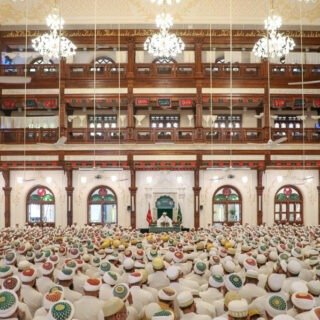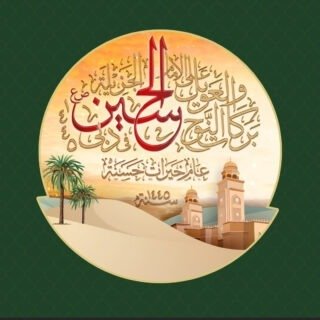Reflections
On the eve of 19th Shahr Allah, 40 H, Amirul Mumineen Maulana Ali b. Abi Talib AS saw a dream wherein Jibra’eel took two stones on the Mount of Abu Qubays and struck them together, the sound of which reverberated in each and every home. When Imams Hasan and Husain’s AS queried the meaning of this dream, Amirul Mumineen AS explained that in the coming dawn would be his shahādat, and that his māʾtam and bukāʾ would take place in each and every home. Mumineen witnessed one manifestation of this māʾtam and bukāʾ today as imānī homes the world over were blessed with excerpts from the mawāʿiẓ nūrānīyya of three Duʿat Mutlaqeen delivered on the 19th of Shahr Allah from three different years: Syedna Taher Saifuddin’s RA from 1382, Syedna Mohammed Burhanuddin’s RA from 1425 and Syedna Aali Qadr Mufaddal Saifuddin’s TUS from 1436.
This extraordinary waʿaẓ mubārak compilation began with Syedna Mohammed Burhanuddin’s RA kalimāt nūrānīyya in which he begins with the glad tiding given to Maulana Ali AS by Rasul Allah SA; that the angels prayed salam upon him with the address, “Amirul Mumineen” (Commander of the Faithful). A special attribute was used by Rasul Allah SA to describe the followers of Maulana Ali AS; fāʾizūn: the victorious. At Ghadir-e-Khum, the two ascended the minbar together where Rasul Allah SA declared naṣṣ upon Maulana Ali AS before 70,000 Muslimeen thus ensuring the unceasing succession of a ‘Maula’ and an ‘Amirul Mumineen’ in each and every day and age.
Today the presence of Imam al-Zaman AS in satr is established by the existence of his Dai and his Dawat. Logic dictates that ‘if the sun has risen, then it is day’, and likewise, ‘if it is day then the sun has risen’. Thus the presence of the Dai proves the existence of the Imam, and, in satr, he assumes the very position of the Imam.
Syedna Burhanuddin RA mentioned that Syedna Abdul Qadir Najmuddin RA used to regularly refer to Syedna Jafar bin Mansur al-Yemen’s RA treatise named ‘Tawil al-Zakat’ during his final years. Later, during Syedna Abdullah Badruddin’s RA reign when sabaq with Syedi Tayyeb Zainuddin’s QR was halted due to his being away, Syedna RA chose this same treatise to personally impart to his successor, Syedna Taher Saifuddin RA.
The treatise is a highly specialised one, and only those with the appropriate knowledge will be privy to its meanings whilst to others it will make no sense at all. It is like a book on mathematics that will make sense to those with knowledge of the discipline, but will seem merely a series of numbers to those who have none. In it, Syedna Jafar RA has explained the meaning of all the various forms of zakat such as gold, silver and livestock.
One meaning of ‘zakat’ is purity and cleanliness, and the offering of it is a means of cleansing the soul. Another meaning of zakat is an ‘increase’. In giving zakat it may seem to decrease one’s wealth, but actually this giving enables one to gain invaluable treasures of Maula’s TUS duʿāʾ mubārak thereby leading to both spiritual as well as material increase. Maulana Burhanuddin RA instructed Mumineen to review their ‘balance sheets’ every year and give one fortieth by calculation.
Syedna Burhanuddin RA stated that in the Quran, Allah Taʿālā states that ‘those who enter jannat will be adorned with bracelets of gold and garments of silk’ and in all three of today’s waʿaẓ mubārak excerpts there was mention of gold; and in particular of alchemy. Al-kimiya is the ancient art of turning base metals into gold but here we came to know that it was not mere myth but a veritable science known only to a very few. Syedna Taher Saifuddin RA recollected that he had actually witnessed such a process and he described why so very few of those who attempt it are successful. The person who wishes to do alchemy must first and foremost abide by all the conditions stipulated to him by the one who has given him the elixir, otherwise, he will inevitably fail. He narrated how one individual was shown the art and was given 16 bottles of elixir from which he was given leave to make no more than one tola (around 10g) of gold everyday, using elixir equivalent only to the wing of an insect. In theory, the 16 bottles could last for decades and potentially create millions of tolas of gold. However, the provider’s condition was that only one tola was to be made per day. On the first day, the individual was successful in transforming the base metal into a single tola of gold but on the second day he thought with so many bottles, why limit production to a single tola? He heated the copper and added the elixir to make 2 tolas of gold. The next day he tried again but this time he failed in increasing production despite using the proportional quantity of elixir. The next day he decided to return to making one tola but now failed to manage even that. The 16 bottles now lay as they were; he had transgressed his bounds.
Alchemy, being the preserve of so very few, will always remain a mythical quantity. Yet, just as it was said that it is known to be day if the Sun is risen then surely the evidence of the transformation of souls that is the preserve of the Awliya Allah AS, is proof that a similar transformational process exists for these metals to be turned into gold.
True alchemy is the benevolent grace of Aale Mohammed AS as Syedi Abdeali Imaduddin QR states:
Alchemy is a supreme craft; and that craft is but a merciful glance from him (Imam of Aale Mohammed AS).
The Fatimi Imams AS ruled from al-Qahira (Cairo) for close to 200 years, their benevolence reaching all. The munificence and opulence of the Fatimi state led some historians to assert that they must have knowledge of alchemy to fund their expenses. In truth it was the alchemy of their conduct, the barakat of their presence that enabled such prosperity. The Duʿat Mutlaqeen AS today are vessels of this barakat, and the blessings of their days, ‘Barakāt Ayyām al-Duʿāt al-Rāshidīn’ (lit, ‘The Blessings of the Days of the Rightly Guided Duat’; this was one of the names of the risāla ramaḍānīya Syedna Taher Saifuddin RA composed in 1382 H) are truly golden. Their barakat transforms our souls into gold, allowing them to remain unaffected by the fires of the vagaries of this world no matter how intense. Regardless of how the world changes and becomes embroiled in turmoil, a Mumin — like gold — remains unchanged while his adversaries – seeing this stability – are consumed by the fire of their hatred and jealousy. The Arabic word for creed or religious denomination, madh-hab, is derived from the Arabic word for gold, dhahab, which indicates that the Ahle Bayt’s AS madh-hab, which has remained unchanged for millenia, transforms its adherents into dhahab – gold. Maulana Burhanuddin RA stated that ‘900 years have passed since Syedna Zoeb RA and today before you is Mohammed Burhanuddin; times change, circumstances change and will keep on doing so, yet we remain gold throughout!’
Syedna Taher Saifuddin’s RA kalimāt nūrānīyya, which Mumineen had the honour of listening to after Syedna Burhanuddin’s RA, demonstrated the continuity and concord of the Duʿat’s wisdom and the golden, unchanging and unwavering barakat of their blessed words. Syedna Taher Saifuddin RA declared that only the Kalima al-Shahāda of the one who observes the shahāda of Amirul Mumineen RA is accepted. Born in the Kaʿba, his first act was a sajda upon the Rukhāmat-e-Hamrāʾ to his Creator and likewise his final deed was a sajda in the masjid of Kufa. Between these two sajdas he aided Rasul Allah SA in firmly and irrevocably establishing Islam.
During a visit of his to Lahore, a professor, who was of the Hanafi faith and a devotee of the Ahle Bayt AS, professed to Syedna Taher Saifuddin RA that the loftiest of Amirul Mumineen’s SA glories was surely the patience and restraint he showed following the passing of Rasul Allah SA. Had he not done so, the religion of Islam would not have survived till this day.
It is this same forbearance and will that we see in the Duʿat Mutlaqeen AS. Syedna Taher Saifuddin RA spoke of how the Advocate-General of Bombay, Sir Thomas Strangman, who had been influenced by Dawat’s adversaries in their nefarious cause, ultimately came to write about him in a book as being of an ‘iron will’ despite the seemingly frailty of his physique. He wrote further of how Syedna had galvanized the Dawat in an age when religion was looked upon far less favourably than before.
Syedna Taher Saifuddin RA was destined to rid Dawat of malign elements which had festered for many years. In 1298 H in Karachi, his predecessor the 47th Dai al-Mutlaq, Syedna Abdulqadir Najmuddin RA was asked why he continued to show restraint against these elements, and he explained that ‘the fifth to come after me would set them straight’ giving glad tidings of the advent of Syedna Taher Saifuddin RA. Despite their continuous malevolent efforts Syedna Saifuddin expressed his indifference to them when he stated that he resides in the city of moḥabbat, and were it not for the duʿāʾ of Nuh Nabi AS he would not even bother with them; ‘I cannot find time from praying for the betterment of Mumineen!’
The barakat of living in these days of the Duʿat is so great, that the mere mention of their names emboldens Mumineen, inspiring them towards good. In his bayān mubārak, which followed that of his predecessors not only in sequence but style and its emphatic love for Mumineen, Syedna Aali Qadr Mufaddal Saifuddin TUS stated that the mention of Syedna Burhanuddin’s RA name gives Mumineen the courage and resolve to undertake numerous tasks: ‘Syedna Burhanuddin RA has habituated all of us to carry out good deeds!’
Syedna Taher Saifuddin RA mentioned that whoever receives the honour of the khidmat of Duat Mutlaqeen AS is indeed fortunate, and the one who holds himself back loses out. Echoing his respected grandfather’s sentiment and words, Mufaddal Maula TUS explained that when in namaz one must neither precede the imam nor lag behind him and that the same applies to Dawat and khidmat. One must adhere to the position where Maula has placed him. Khidmat is a trait we are imbibed with from an early age and Maulana Saifuddin TUS recalled how much they took pride, as children, in serving something to those breaking their fast; even if it was just a date. This was the month of intensifying our khidmats, of feeding others, of embracing each other, of forgiving and seeking forgiveness for our transgressions against one another.
The golden jubilees of both Syedna Taher Saifuddin RA and Syedna Mohammed Burhanuddin RA combined with the golden age of Syedna Aali Qadr Mufaddal Saifuddin TUS have instilled in Mumineen the properties of gold. As the fires of trials and tribulations rage, we seek to use them to further rid us of impurities and reveal the brilliance of our madh-hab and its commitment to the betterment of both worlds.
The waʿaẓ mubārak was concluded with the narration of the shahadat of Imam Husain and Maulana Ali AS. Speaking of the long necked geese that had been gifted to Amirul Mumineen AS Maulana Mufaddal Saifuddin TUS asked, ‘when these geese did not let go of Ali, so would Ali’s Shia do so? Will the necks of Mumineen not long extend near Allah, to see the eternal reward?
May Allah Taʿālā keep us forever steadfast to Syedna Aali Qadr Mufaddal Saifuddin TUS and give him a long and healthy life until qiyāmat.








